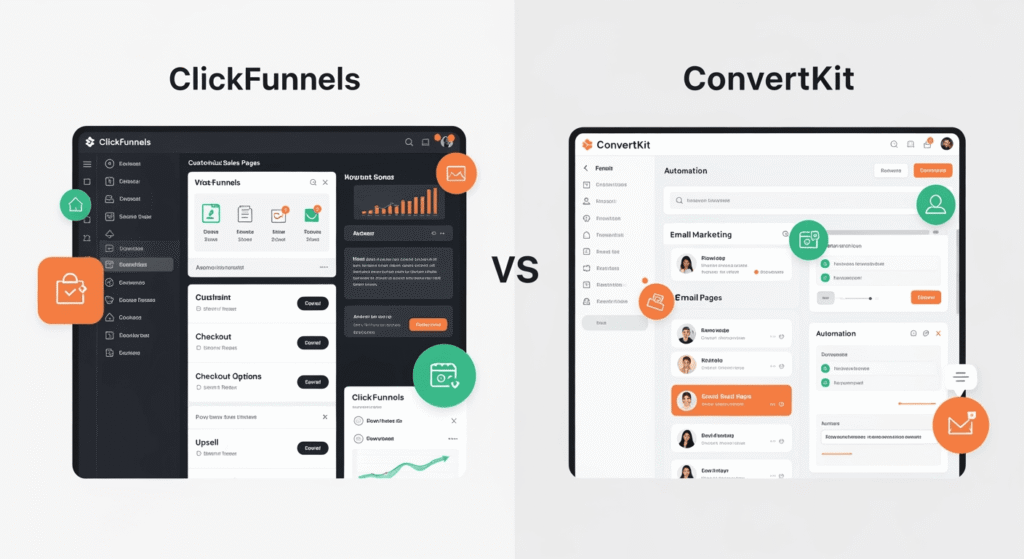ClickFunnels vs ConvertKit: The Definitive 2025 Comparison

ClickFunnels vs ConvertKit: Which One Deserves a Spot in Your Digital Toolbox?
Picture this: You’ve got a killer product (maybe it’s a course, maybe it’s an eBook about sourdough—no judgment), the passion to promote it, and you’re ready to turn your audience from browsers to buyers. Now comes the real conundrum… what digital tools will carry your vision across the finish line?
It’s like choosing between Batman’s utility belt or Iron Man’s suit—each has its perks. Do you want a robust sales funnel platform with pages, checkouts, and upsells baked right in? Or do you need a sleek email marketing machine to build audience loyalty and drive revenue passively?
In this ultimate 2025 showdown of ClickFunnels vs ConvertKit, we’re digging into what each platform does best—and not-so-best—so you can make the right call. Whether you’re selling a course, growing a newsletter, or killing it on webinars, this guide will help you find the right fit for your toolbox.
Spoiler alert: No matter which one you pick, you’ll supercharge your strategy. But only one will make your life way easier (and maybe help you avoid grey hairs).
Table of Contents
Quick Overview of ClickFunnels vs ConvertKit

ClickFunnels and ConvertKit are both power tools—but they’re not for the same job. It’s like a power drill vs a paint sprayer. Each one is built with a specific purpose in mind, and using the wrong one can make your project more complicated than necessary.
ClickFunnels is a full-scale sales funnel builder designed to guide leads through a defined journey—from opt-in to checkout, with upsells, webinars, and more. It’s ideal for entrepreneurs, marketers, agencies, and eCommerce sellers who want to sell directly without duct-taping 19 tools together.
ConvertKit, on the flip side, was born for creators. Think authors, bloggers, podcasters, and course creators. Its specialty is email marketing—with automation tools, segmentation, and a slick user experience that helps you build meaningful relationships with your audience.
| Feature | ClickFunnels | ConvertKit |
|---|---|---|
| Primary Use | Sales Funnels & Pages | Email Marketing & Automation |
| Ideal For | Marketers, Entrepreneurs | Bloggers, Creators, Course Creators |
| Landing Pages | Yes, robust builder | Basic via landing page editor |
| Email Marketing | Basic (or via integrations) | Advanced automations and tagging |
| Pricing Starts At | $147/month | Free plan available; Paid from $15/mo |
Feature Comparison: ClickFunnels vs ConvertKit

Let’s roll up our sleeves and look feature-for-feature. This is where your “aha” or your “uh-oh” moments will probably happen.
| Feature | ClickFunnels | ConvertKit |
|---|---|---|
| Drag-and-Drop Funnel Builder | ✓ Yes (ClickFunnels) | ✗ No |
| Built-in Shopping Cart | ✓ Yes (ClickFunnels) | ✗ No |
| Email Automation Workflows | ✗ Limited | ✓ Advanced (ConvertKit) |
| A/B Testing | ✓ Yes | ✓ Yes |
| Affiliate Management (Backpack) | ✓ Yes (Premium) (ClickFunnels) | ✗ No |
| Digital Product Delivery | ✓ Yes (ClickFunnels) | ✓ Yes (ConvertKit) |
| Integrations | 100+ | 70+ |
| Webinar Hosting | ✓ Via Add-on (ClickFunnels) | ✗ No |
| CRM Features | ✓ Built-In | ✗ Integrations |
Pricing Breakdown

Let’s talk cash. Because as powerful as these tools are, if they make your wallet cry, they’re not worth it.
| Plan Tiers | ClickFunnels | ConvertKit |
|---|---|---|
| Free Plan | ✗ No | ✓ Yes (up to 1,000 subs) (ConvertKit) |
| Entry Price | $147/month (ClickFunnels) | $15/month (ConvertKit) |
| Mid-Tier | $197/month (Pro) (ClickFunnels) | $29–$79/month (varies) (ConvertKit) |
| Top Tier | $297/month (Funnel Hacker) (ClickFunnels) | Enterprise pricing available |
| Free Trial | ✓ 14-day free trial (ClickFunnels Free Trial) | ✓ Free forever (limited) (ConvertKit) |
- ConvertKit has a generous free plan—great if you’re just getting started on email marketing.
- ClickFunnels is pricier, but you’re also getting A LOT: funnel builder, cart, CRM, affiliate tools. Still, a $147 bill hits different when you’re just dipping your toe into the online business world.
For marketers curious about options, learn more in ClickFunnels Alternative: 5 Game-Changing Tools to Try Now.
Ease of Use & User Experience
Some platforms make you feel like a tech guru. Others have you rage-Googling “how to add an image.” Let’s see how each one feels in real use.
ClickFunnels
- The visual funnel builder is super intuitive once you get the hang of it.
- Comes with drag-and-drop templates, which are optimized to convert.
- Onboarding walks you through your first funnel step-by-step—which is great unless you skip instructions like you’re building IKEA furniture.
- The dashboard? Functional, but a bit ’90s. If nostalgia’s your thing—bonus!
Learning curve: Moderate to steep. Expect some “can I break it?” moments early on.
ConvertKit
- Clean and minimal layout designed with content creators in mind.
- Visual automation builder is one of the best in the game.
- Broadcasts, sequences, tagging—all intuitive and efficient.
- Excellent educational content built-in to help you get started.
Learning curve: Smooth as grandma’s banana bread. And just as satisfying.
Pros & Cons of Each
ClickFunnels Pros
- Truly all-in-one for selling: pages, payments, upsells, and more.
- Pre-built funnel templates give you a head start.
- Affiliate system (Backpack) available in higher tiers.
- Great for webinars, events, and launches.
ClickFunnels Cons
- Pricey, especially for smaller businesses.
- Limited email automation features compared to specialized tools.
- Interface can feel bulky or outdated.
- Overkill if you’re only sending newsletters or simple promotions.
ConvertKit Pros
- Free plan is perfect for side hustlers or small creators.
- Email automation and tagging = segmentation made easy.
- Landing pages and forms are simple but effective.
- Designed with content-focused businesses in mind.
ConvertKit Cons
- No true funnel builder (sorry, sales ninjas).
- Basic landing page options compared to dedicated page builders.
- Slightly fewer integrations.
- Not ideal for eCommerce or high-volume sales.
Which One Should You Choose?
Choose ClickFunnels if:
- You’re launching or scaling digital products/courses.
- You want a funnel-first sales machine with upsells, downsells, and one-click order bumps.
- Webinars and online events are a key part of your strategy.
- Your budget can handle $147/month or more.
ClickFunnels is like having a personal team of marketers working 24/7… in software form—with fewer coffee breaks. Try starting your journey with the ClickFunnels Free Trial.
Choose ConvertKit if:
- You’re a blogger, creator, or coach focused on community engagement.
- Email is your #1 way to connect and convert.
- You love visual automations but don’t need complex funnels.
- You’re budget-conscious or just starting out.
ConvertKit is your penlight for reaching inboxes instead of building rocket funnels, but it works brilliantly when used with precision. Start building your audience today with Kit (ConvertKit).
Verdict? If ClickFunnels is the Swiss Army knife with a laser attachment, ConvertKit is the high-performance fountain pen every storyteller wants for crafting reader-love and loyalty.
Conclusion — ClickFunnels vs ConvertKit in 2025
At the end of the (email) day, both ClickFunnels and ConvertKit bring serious firepower to your digital marketing strategy—but they fight different battles.
ClickFunnels is the go-to if you’re selling hard and need landing pages, checkouts, upsells, and a sales pipeline that hums. Perfect if you want an integrated, conversion-first platform.
ConvertKit? That’s your champion if you’re building a loyal audience, communicating regularly, and prefer simplicity over sales tactics. It’s clean, creator-friendly, and won’t break the bank (or your spirit).
So what’s it going to be? Funnels or followers? Sales or subscribers? Iron Man or Batman?
Pick your weapon. Test it out. Grow your empire.
And remember—don’t just choose a tool. Choose the one that makes your life easier. Because you’ve got better things to do than live in tech chaos.
Like finally hitting “send” on that newsletter… or eating a sandwich before it goes soggy.
Ready to take action? Pick a platform, start your free trial, and get building. Trust us—it’s a lot more fun than reading another comparison post. Unless they’re all this fun. 😉
FAQ
- Q1: What is the main difference between ClickFunnels vs ConvertKit?
- A: ClickFunnels is designed for creating sales funnels and selling products, while ConvertKit is focused on email marketing and subscriber engagement.
- Q2: Is ClickFunnels better than ConvertKit for beginners?
- A: ConvertKit is more beginner-friendly for email marketing. ClickFunnels is better for those needing a full sales solution, but it comes with a steeper learning curve.
- Q3: Can I use ConvertKit with ClickFunnels?
- A: Absolutely. Use integrations or Zapier to run ClickFunnels funnels while managing emails in ConvertKit.
- Q4: Which platform is cheaper, ClickFunnels or ConvertKit?
- A: ConvertKit is more budget-friendly, with a free plan and lower entry price. ClickFunnels starts at $147/month.
- Q5: Who should use ClickFunnels vs ConvertKit in 2025?
- A: ClickFunnels is ideal for marketers and digital sellers who need complete funnel control. ConvertKit suits creators and bloggers focused on email-driven audience growth.
Recommended Services / Affiliate Picks
ClickFunnels Free Trial
ClickFunnels is a platform that allows users to build sales funnels and landing pages efficiently.
Start now with the Sales Funnel Builder / Landing Pages.
Alternatives include Kartra, Leadpages, Unbounce, GoHighLevel (GHL).
Kit (ConvertKit)
ConvertKit is a mailing system designed for creators to build their email lists and communicate with their audiences.
Get started with the Mailing System (Email Marketing + CRM).
Alternatives include Mailchimp, ActiveCampaign, AWeber.
Sources









